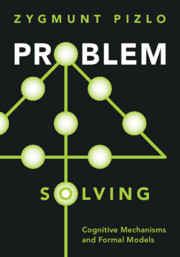Book contents
- Problem Solving
- Problem Solving
- Copyright page
- Dedication
- Contents
- Figures
- Tables
- Preface
- Chapter 1 Problem Solving
- Chapter 2 Animal Problem Solving
- Chapter 3 Modern Research on the Human Ability to Solve Problems that Have Large Search Spaces
- Chapter 4 The Exponential Pyramid Representation that Compensates for Exponentially Large Problem Spaces
- Chapter 5 Heuristic Function, Distance, and Direction in Solving Problems
- Chapter 6 Insight and Creative Thinking
- Chapter 7 Inference in Perception
- Chapter 8 Cognitive Inferences, Mental Representations
- Chapter 9 Theory of Mind
- Chapter 10 Solving Problems in Physics and Mathematics
- Chapter 11 Summary and Conclusions
- References
- Index
Chapter 10 - Solving Problems in Physics and Mathematics
Published online by Cambridge University Press: 23 June 2022
- Problem Solving
- Problem Solving
- Copyright page
- Dedication
- Contents
- Figures
- Tables
- Preface
- Chapter 1 Problem Solving
- Chapter 2 Animal Problem Solving
- Chapter 3 Modern Research on the Human Ability to Solve Problems that Have Large Search Spaces
- Chapter 4 The Exponential Pyramid Representation that Compensates for Exponentially Large Problem Spaces
- Chapter 5 Heuristic Function, Distance, and Direction in Solving Problems
- Chapter 6 Insight and Creative Thinking
- Chapter 7 Inference in Perception
- Chapter 8 Cognitive Inferences, Mental Representations
- Chapter 9 Theory of Mind
- Chapter 10 Solving Problems in Physics and Mathematics
- Chapter 11 Summary and Conclusions
- References
- Index
Summary
Chapter 10 discusses physics and math problems. Both have received some attention in the problem solving and education communities. The chapter begins with physics problems and evaluates what is called "intuitive physics," specifically, how well humans can understand the laws of physics before taking any classes in physics. Intuitive physics was introduced in Chapters 1 and 2 when animal problem solving was discussed. By now you know how important symmetry is in physics and that all basic phenomena can be explained by a least-action principle. Surprisingly, both of these concepts have been absent from research done on intuitive physics as well as absent from most or all conventional high school education. One reason for this is that these concepts require more sophisticated math than the math used in Newtonian physics. This chapter reviews a few well-known studies on intuitive physics and goes on to studies of causality. In the second half of the chapter, Polya’s contributions to problem solving in mathematics are highlighted and reviewed. This review focuses on his treatment of optimization problems. Polya’s elementary exposition of optimization is of particular interest because it suggests that optimization can be taught before college. Polya is aware of the relationship between optimization problems and a least-action principle, so his examples contribute to problem solving in both math and physics. If optimization and symmetry can be included in high school, or, perhaps, even in elementary school, this would revolutionize education in the STEM subjects, that is, science, technology, engineering, and mathematics.
- Type
- Chapter
- Information
- Problem SolvingCognitive Mechanisms and Formal Models, pp. 155 - 174Publisher: Cambridge University PressPrint publication year: 2022



